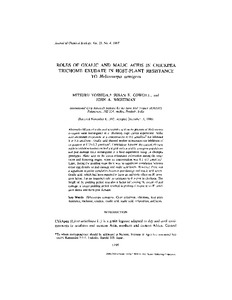Roles of oxalic and malic acids in chickpea trichome exudate in host-plant resistance to helicoverpa armigera
Abstract
Effects of malic acid and oxalic acid on oviposition of Helicoverpa armigera were investigated in a laboratory cage choice experiment. Malic acid stimulated oviposition at a concentration of 0.6 μmol/cm2 but inhibited it at 3.4 μmol/cm2. Oxalic acid showed neither stimulation nor inhibition of oviposition at 0.25–1.7 μmol/cm2. Correlations between the amount of these acids in trichome exudate on leaf and pod surface and H. armigera populations and pod damage were investigated in a field experiment using 14 chickpea genotypes. Malic acid on the leaves stimulated oviposition during the vegetative and flowering stages, when its concentration was 0.1–0.7 μmol/cm2. Later, during the podding stage there was no significant correlation between either egg density or pod damage and malic acid levels. However, there was a significant negative correlation between pod damage and oxalic acid levels. Oxalic acid, which had been reported to have an antibiotic effect on H. armigera larvae, has an important role in resistance to this pest in chickpea. The length of the podding period was also a factor influencing the extent of pod damage; a longer podding period resulted in prolonged exposure to H. armigera attack and more pod damage

